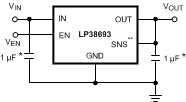SNVS321O January 2005 – December 2015 LP38691 , LP38691-Q1 , LP38693 , LP38693-Q1
PRODUCTION DATA.
- 1 Features
- 2 Applications
- 3 Description
- 4 Revision History
- 5 Pin Configuration and Functions
- 6 Specifications
- 7 Detailed Description
- 8 Application and Implementation
- 9 Power Supply Recommendations
- 10Layout
- 11Device and Documentation Support
- 12Mechanical, Packaging, and Orderable Information
1 Features
- Wide Input Voltage Range (2.7 V to 10 V)
- All WSON Options are Available as AEC-Q100 Grade 1
- 2% Output Accuracy (25°C)
- Low Dropout Voltage: 250 mV at 500 mA (Typical,
5 V Out) - Precision (Trimmed) Bandgap Reference
- Ensured Specifications for –40°C to 125°C
- 1-µA Off-State Quiescent Current
- Thermal Overload Protection
- Foldback Current Limiting
- Ground Pin Current: 55 µA (typical) at full load
- Enable Pin (LP38693)
2 Applications
- Hard Disk Drives
- Notebook Computers
- Battery-Powered Devices
- Portable Instrumentation
3 Description
The LP3869x low-dropout CMOS linear regulators provide tight output tolerance (2% typical), extremely low dropout voltage (250 mV at 500-mA load current, VOUT = 5 V), and excellent AC performance using ultralow equivalent series resistance (ESR) ceramic output capacitors.
The low thermal resistance of the WSON, SOT-223, and TO-252 packages allow use of the full operating current even in high ambient temperature environments.
The use of a PMOS power transistor means that no DC base-drive current is required to bias it, thus allowing ground pin current to remain below 100 µA regardless of load current, input voltage, or operating temperature.
Device Information(1)
| PART NUMBER | PACKAGE | BODY SIZE (NOM) |
|---|---|---|
| LP38691 | TO-252 (3) | 6.58 mm × 6.10 mm |
| WSON (6) | 3.00 mm × 3.00 mm | |
| LP38693 | SOT-223 (5) | 6.50 mm × 3.56 mm |
| WSON (6) | 3.00 mm × 3.00 mm | |
| LP38691-Q1 | WSON (6) | 3.00 mm × 3.00 mm |
| LP38693-Q1 |
- For all available packages, see the orderable addendum at the end of the data sheet.
Typical Application Circuits

